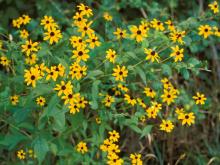Wildflowers, Grasses and Other Nonwoody Plants
Media

Species Types
Scientific Name
Silene virginica
Description
Fire pink is a low, clump-forming perennial with many slender, spreading stems that are sticky from glandular hairs, with open clusters of bright red flowers. This showy native Missouri plant is growing in popularity among home gardeners.
Media

Species Types
Scientific Name
Impatiens capensis
Description
Many Missouri children learn about this orange-flowered native plant by playing with the juicy green seedpods, which, when ripe, "explode" upon the slightest touch. This is jewelweed's mechanism for seed dispersal, and it's the reason for the name "touch-me-not."
Media

Species Types
Scientific Name
Trillium sessile
Description
The flower of wake robin, or trillium, has 3 petals and 3 sepals, and 3 leaves that subtend the solitary flower. The petal color varies in this common woodland spring wildflower, but it is most commonly brownish or maroon.
Media

Species Types
Scientific Name
Lilium michiganense
Description
This native lily looks a lot like the Asian “tiger lily” that is commonly cultivated in gardens. Michigan lily, however, has leaves mostly in whorls and lacks the round “bulblets” that tiger lily forms in its leaf axils.
Media

Species Types
Scientific Name
Aquilegia canadensis
Description
Native to much of eastern North America, eastern red columbine's range almost matches the breeding territory of the ruby-throated hummingbird, its number-one pollinator. Its bloom time matches the hummingbird's northward migration, too.
Media

Species Types
Scientific Name
Lobelia cardinalis
Description
Cardinal flower provides a splash of bright red along streams and rivers, in bottomland forests, in ditches by roads, and in other wet places. It's a long-blooming Missouri native wildflower.
Media

Species Types
Scientific Name
Helianthus annuus
Description
Whether you see the wild form or any of the many cultivated varieties, this poster child of the sunflower family cultivates its own sunny impression. Common sunflower is also the state flower of Kansas.
Media

Species Types
Scientific Name
Rudbeckia triloba
Description
Brown-eyed Susan is a bushy perennial with much-branching stems and plenty of flowerheads. Compared to Missouri’s other Rudbeckia species, its flowerheads are the smallest, growing to only about one inch across.
Media

Species Types
Scientific Name
Phlox paniculata
Description
Perennial phlox has big, showy clusters of flowers. A tall, late-blooming native wildflower of woodland borders, steamsides, and gravel bars, it is also an old-fashioned garden favorite.
Media

Species Types
Scientific Name
Subfamily Asclepiadoideae
Description
Milkweeds are a group of plants that used to have their very own family. Now part of the dogbane family, they’re still a pretty distinctive group.
See Also
About Wildflowers, Grasses and Other Nonwoody Plants in Missouri
A very simple way of thinking about the green world is to divide the vascular plants into two groups: woody and nonwoody (or herbaceous). But this is an artificial division; many plant families include some species that are woody and some that are not. The diversity of nonwoody vascular plants is staggering! Think of all the ferns, grasses, sedges, lilies, peas, sunflowers, nightshades, milkweeds, mustards, mints, and mallows — weeds and wildflowers — and many more!





















